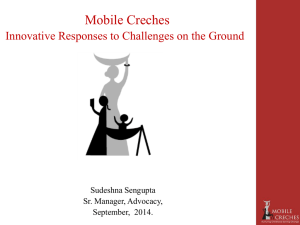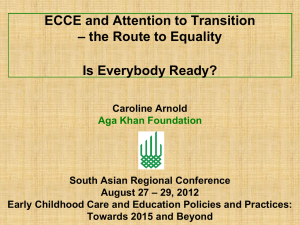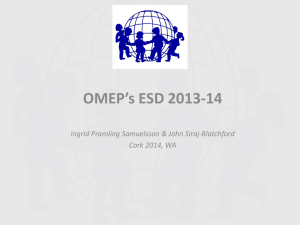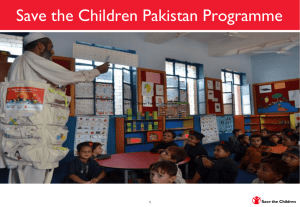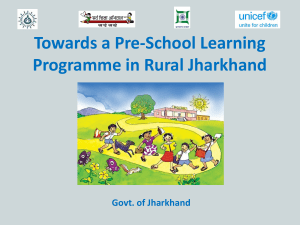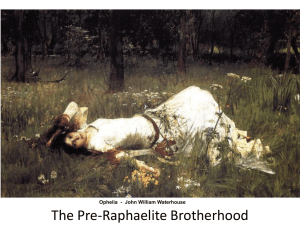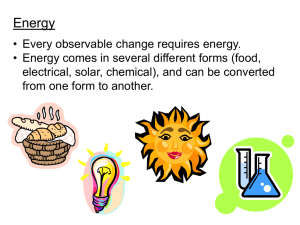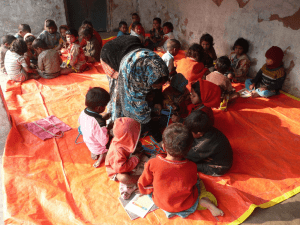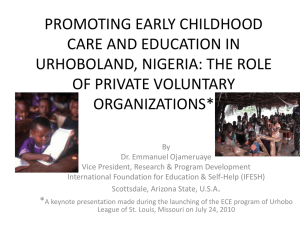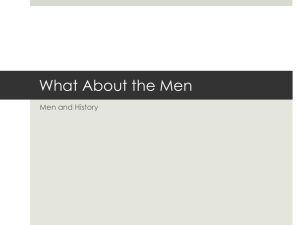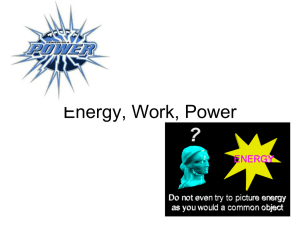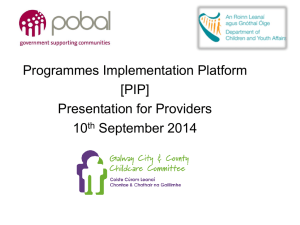The Role of GPE – Aigly Zafeirakou
advertisement
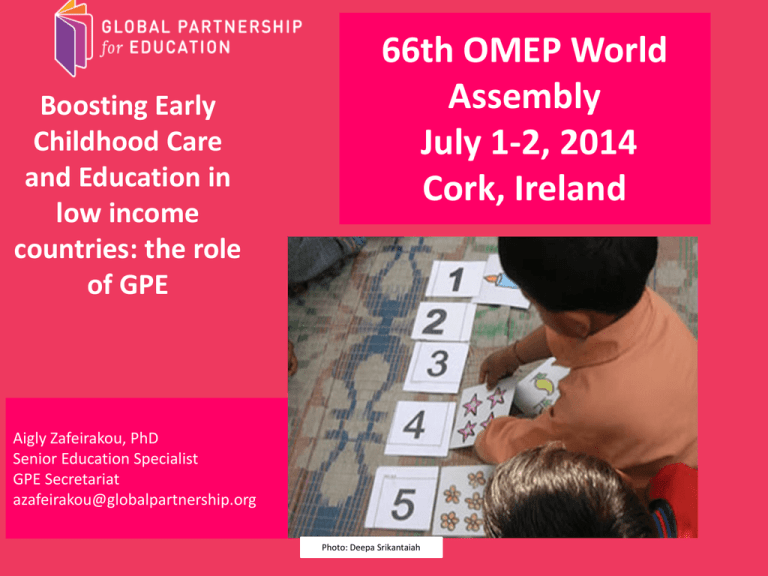
Boosting Early Childhood Care and Education in low income countries: the role of GPE 66th OMEP World Assembly July 1-2, 2014 Cork, Ireland Aigly Zafeirakou, PhD Senior Education Specialist GPE Secretariat azafeirakou@globalpartnership.org Photo: Deepa Srikantaiah Outline 1. What is the Global Partnership for Education? 2. The picture of ECCE in low income countries 3. How global and local partners could support ECCE? - Call to Action: Investing urgently in ECCE - The added value of OMEP The issue: access, equity and quality of education • Despite huge gains in access, approximately 200 million children in primary school in developing countries are struggling to read even basic words, following several years of schooling! • The Global Partnership for Education Partners have put as priority to achieve access, equity and quality education for all. A partnership for basic education to address access, equity and quality Low income recipient countries Donor countries Multilateral, bilateral organizations Academia, civil society organizations, NGOs, the private sector GPE strategy To coordinate a global effort to deliver a good quality education to all girls and boys, prioritizing the poorest and most vulnerable Goals • Access for all • Learning for all • Building for the future (systems) • Reaching every child (marginalized, conflict states) ECCE in the GPE strategy Within the strategic goals: Access for All, Learning for All, and the strategic objective 3: Dramatic increase in the number of children learning and demonstrating mastery of basic literacy and numeracy skills by grade 3, ECCE has an important role to play! ECCE in the GPE strategy Supporting efforts to increase Early Childhood Education especially for the more marginalized and disadvantaged The GPE approach • Development of a sound Education Sector Plan • Promote in-country partners collaboration oLocal Education Group oSupervising Entity • Implementation of the Plan- GPE Grant • Monitoring the implementation of the Plan • Technical support The GPE approach at country level Domestic and international investment (i.e. GPE grant) Education Sector Plan Implementation ECCE components Monitoring and Evaluation Early Childhood Care and Education and the Global Partnership for Education Processes The Global Partnership for Education supports ECCE with: Financial support through GPE grants for eligible countries Technical advice, knowledge development and sharing, support of networks and platforms Entry points for ECCE operationalization Two levels: System Level: Education Sector Plans Technical level: the appropriate development of effective, essential, curricula package (s) for developing quality Early Childhood Education with quality language and emergent literacy components; what works from pilots and innovations is crucial! ECCE: what we know: Proving quality early childhood care and education, language development and emergent literacy experiences help young children and especially the poorest and most disadvantaged to improve primary school achievements and education success. Preschoolers in emergent literacy activities, Albania, 2010 (photo: Author) 12 I. What we know Early successful learning, leads to later successful learning In fact, good quality ECCE results in: cost-savings and increased efficiency in primary education: higher attendance and achievement, lower repetition and drop-out rates, less remedial and special education children who are ready for school and for reading with early/emergent/preliteracy skills I. What we know The starting point: holistic children development TO SCHOOL Cognitive Physical Linguistic Socio-emotional Development is a multidimensional process It contains 4 basic interconnected areas of child development, from birth to 6-8 years old Definition: United Nations Convention on the Rights of children 2006 FROM BIRTH I. What we know Entry point: language development and emergent literacy as predictors of success in school and learning This applies for all young children, but especially for young children from disadvantaged environments In low income countries: vocabulary scores of Ecuadorian children aged 36 to 72 months by wealth quartiles Parxson, K. &Schady N., 2005 II. The picture of ECCE in low income countries A kindergarten class attached to a primary school, with an unqualified teacher, Sub-Saharan Africa The disadvantaged • Around 219 million children under 5 are disadvantaged* 61% in Africa 52% in South Asia 39 % in the developing countries (Grantham-McGregor et al.2007) *Disadvantaged children: stunted, living in poverty or both Learning outcomes still lag behind • Early grade reading assessments show a rather dramatic situation despite the fact that access is a success story, during the last decade. • Many children in sub-Saharan Africa are failing to master basic literacy and numeracy skills, even if they complete primary school. The Southern and Eastern Africa Consortium for Monitoring Educational Quality (SACMEQ) The Early Grade Assessment (EGRA) • This is an alarming situation and ECCE has an important role to play in order to overcome! Access Enrollment in preprimary education generally increased between 2000 and 2011 Global Partnership for Education Results Learning Report 2013. http://globalpartnership.org/content/results-learning-report-2013 Access Preprimary gross enrollment. Decade change. Selected GPE countries with 2002 and 2012 data. UIS/UNESCO 120.00 100.00 80.00 60.00 2000 40.00 20.00 0.00 2012 Inequalities: participation in Pre-primary is increasing but still limited and unequal (Global Monitoring Report, 2011) The poorest young children benefit the least Access to ECCE by socio-economic status in selected countries. Latest MICS available data (2005-2012). 120 100 80 60 Poorest 40 20 0 Richest Access to ECCE is concentrated in urban areas Access to ECCE by geographical location in selected countries. Latest MICS available data (2006-2012). 90 80 70 60 50 40 Rural 30 20 10 0 Urban Children from rich families are more likely to participate in ECCE programs Probability for 3- and 4 years old of attending early learning programs: children from the richest 20% compared with children from the poorest 20% Source: Global Monitoring Report, 2010, cited Nanoyama-Tarumi et al. Children of educated mothers are more likely to attend ECD programs Source: GMR 2010, Nonoyama-Tarumi et al. p.52 Private preprimary schools catered to an average of 34 percent of children in 2011 Private, 34 Other, 66 Source: Global Partnership for Education Results Learning Report 2013. http://globalpartnership.org/content/results-learning-report-2013 Percentage of private enrolment. Pre-primary GPE developing partner countries with latest available data (2000-2012) (UIS/Unesco) 100% Country (total pre-primary gross enrollment, private pre-primary enrollment) Eg. The Gambia (30, 77) 25%-49% 11%-24% Nigeria (13,28), Togo Under 10% Cambodia (15,13), Sao (11,30), Cote d'Ivoire (5,35), Burundi Guyana (62,7), Tome (50,14), Nicaragua (5,36), Kenya (51,38), Mongolia (85,7), (55,16), Niger (6,13), Senegal (14, 43), Tanzania (34,5), Nepal (81,17), Vietnam Sierra Leone (9,44), Kyrgyz Rep. (77,21), Ghana (114,22), Yemen (1,45), Lao PDR (24,22), Sudan (24,3), Bangladesh (25,49) (26,23), Solomon Uzbekistan Islands (43,23) (25,0.6), Moldova (79,0.2) No. of countries: 6 9 9 Uganda (13,100), 75%-99% Rwanda (13,100), 50%-74% Burkina Faso Tonga (4,76), The Congo, Dem. Gambia (30,77), (35,100), (4,52), Chad (2, Vanuatu Mauritania 52), Eritrea (2,79), Guinea- (61,100), St. (13,53), Central Bissau (6,84), Lucia (61,100), Afr. (6,55), Benin St. Vincent Ethiopia, (18,56) , Djibouti (78,100), Madagascar (4,57), Myanmar Lesotho (8,91) (9,60), Cameroon (35,100), (30,64), Congo Comoros Rep (14,66), (24,100) Guinea (15,72), Mali (4,72) 11 6 8 Mapping Early Childhood Care and Education (ECCE) in GPE countries: 40 country profiles Structure of the profile sheet Structure of the profile sheet TRENDS- ECCE findings in 48 GPE countries ECCE ECCE AT INCLUDED IN ALL EDUCATION SECTOR PLANS EMERGENT STATE SIGNIFICANT INTERNAL INEQUALITIES (RURAL, POOR, ETHNIC MINORITY AND YOUNG CHILDEN) IN GPE POOREST COUNTRIES MORE COUNTRIES EXPAND PRE-SCHOOL CLASSES AT LEAST 1 YEAR INCREASED GROSS ENROLLMENT CHILDREN 3-5 YRS COMMUNITY-BASED ECCE POPULAR FOR SCALE –UP BUT SUSTAINABILITY? Quality Challenges Examples Obsolete programs and technologies Need for adequate furniture, equipment, library, toys, visual learning aids. Unsatisfactory sanitary conditions in preschool institutions Very few teachers with higher education degree High incompatibility of teacher training with modern early child development requirements Salaries of kindergarten teachers are still very low compared to salaries of production workers GPE country allotments to ECCE in US millions and period Country Total grant Kyrgyz Rep. 12.7/ 2014-2017 Mongolia 12.12/ 2012-14 Moldova 4.4/ 2012-2014 Part of total grant Nepal 59/2009-2014 Uzbekistan 20.7/2014-2017 Nicaragua 15.9/2013-2016 Uganda 7.0/2014-2017 Sierra Leone 1.0/2014-2017 Tanzania mainland 1.7/2013 Eritrea 1.3/ 2014-2017 Ethiopia Less than 1.0 Cameroon Less than 0.5 The Gambia 0.366/ 2013 Yemen 0.88/2013-2016 GPE country allotments to ECCE in US millions and period Country Total grant Part of total grant Tajikistan 13.5/2010-2012* Cambodia 57.4 /2010* Mozambique 90 /2011-2015* * Confirmed allocation to ECCE yet unspecified in GPE Grant Application Document Sources: GPE Grant Application Documents, Project Documents and draft note “SUMMARY OF ECD/ECCE ACTIVITIES INCLUDED IN GPE PROJECTS APPROVED NOVEMBER 2013 IN AFRICA” ECCE Impact evaluations • Mozambique The Promise of Preschool in Africa: A Randomized Impact Evaluation of Early Childhood Development in Rural Mozambique. World Bank, 2012. Cambodia • Impact Evaluation of Three Types of Early Childhood Development Interventions in Cambodia. World Bank, 2013. Ethiopia • Supporting emergent Literacy skills among preschool age children. Save the Children 2014. From ESPs to ECCE/ECD implementation Countries with ECCE comp. in the GPE current grants) Kyrgyz Rep., Nepal, Moldova, Mongolia, Uzbekistan, Nicaragua, Uganda, Yemen, Tajikistan, Cambodia, Mozambique, Cameroon, Eritrea, Ethiopia, Gambia, Niger, Sierra Leone, Tanzania Mainland. In total: around 137 million awarded for specific ECCE and ECD components Activities included in GPE grant proposals • Sub-sector analysis, (2) • Expansion of preschool classes (4) • Modules for initial teacher training, training, Teacher guides (3) • Materials for training (1) • Standards (2) • Impact evaluations (2) • Piloting new approaches (2) • Day care, Parenting programs (3) • Capacity development (2) III. How global and local partners could support ECCE? The road ahead: the role of GPE opportunities for OMEP - Call to Action: Investing urgently in ECCE - Implementing the GPE Strategic plan: Technical Reference Group (TRG) - The added value of OMEP: technical platform part of the TRG? Other critical technical questions for GPE ECCE partners • Define and identify age group intervention ) levels (preschool classes) Programming (qualification of educators / pre-school teachers, curricula, learning and teaching aids, pedagogical materials, emergent literacy etc.) - Appropriate mix in the ground between education, health, nutrition, care, etc. - Education and school readiness as goal, other interventions as enabling factors Nest steps for discussion Multiple opportunities for OMEP action within the GPE: Member of the incoming Techincal Reference Group Contribute to the deliver of the implementation plan but contributing at global and country level in supporting efforts to increase ECE especially for the more marginalized. Provide inputs on new research, thinking and evidence on ECCE programming, essential ECCE packages, ECD, alternative innovative service delivery Contribute to knowledge development, and sharing, analytical work, advocacy (ECCE workshops in Africa 2014)
